Corporate Finance Report: Analysis of Woolworths Limited (2024)
VerifiedAdded on 2021/06/17
|15
|2427
|23
Report
AI Summary
This report presents a corporate finance analysis of Woolworths Limited, a major Australian retail company. It begins with an introduction to corporate finance, followed by a case study of Woolworths, including a brief description of the company and its market analysis. The report examines the company's financial performance, including revenue, net income, and key financial ratios. It then delves into an industry overview, discussing challenges faced by Woolworths, such as market dominance and the rise of online retail. The core of the analysis involves WACC calculations, using the Fama-French model and Covariance/Variance method, and enterprise valuation using the constant free cash flows to firm (FCFF) method and a two-stage FCFF model. The report concludes with a summary of findings, suggesting that the company's capital structure and valuation models indicate potential investment opportunities. The report references various academic journals and online resources to support its analysis, providing a comprehensive overview of Woolworths' financial standing and future prospects.
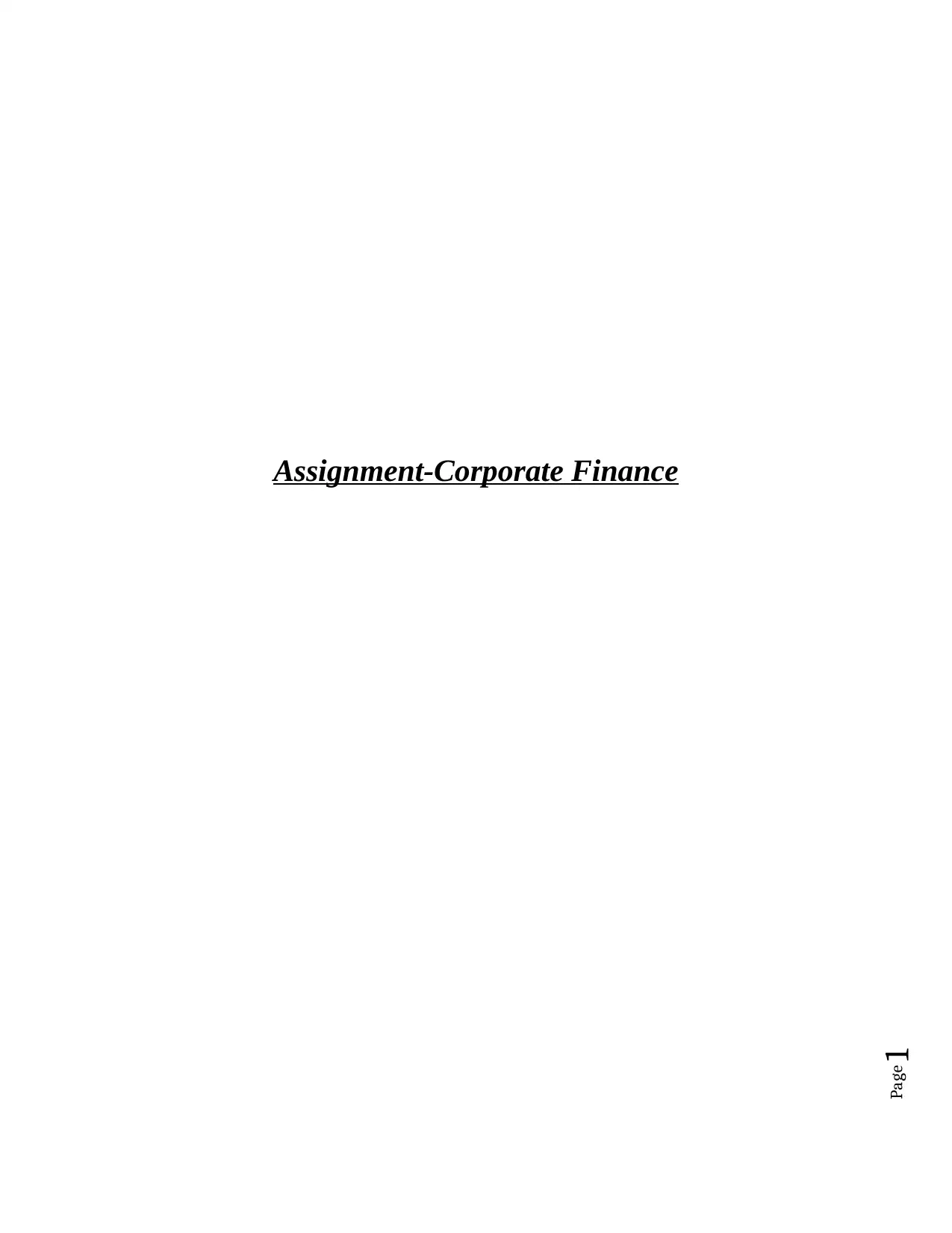
Page1
Assignment-Corporate Finance
Assignment-Corporate Finance
Paraphrase This Document
Need a fresh take? Get an instant paraphrase of this document with our AI Paraphraser
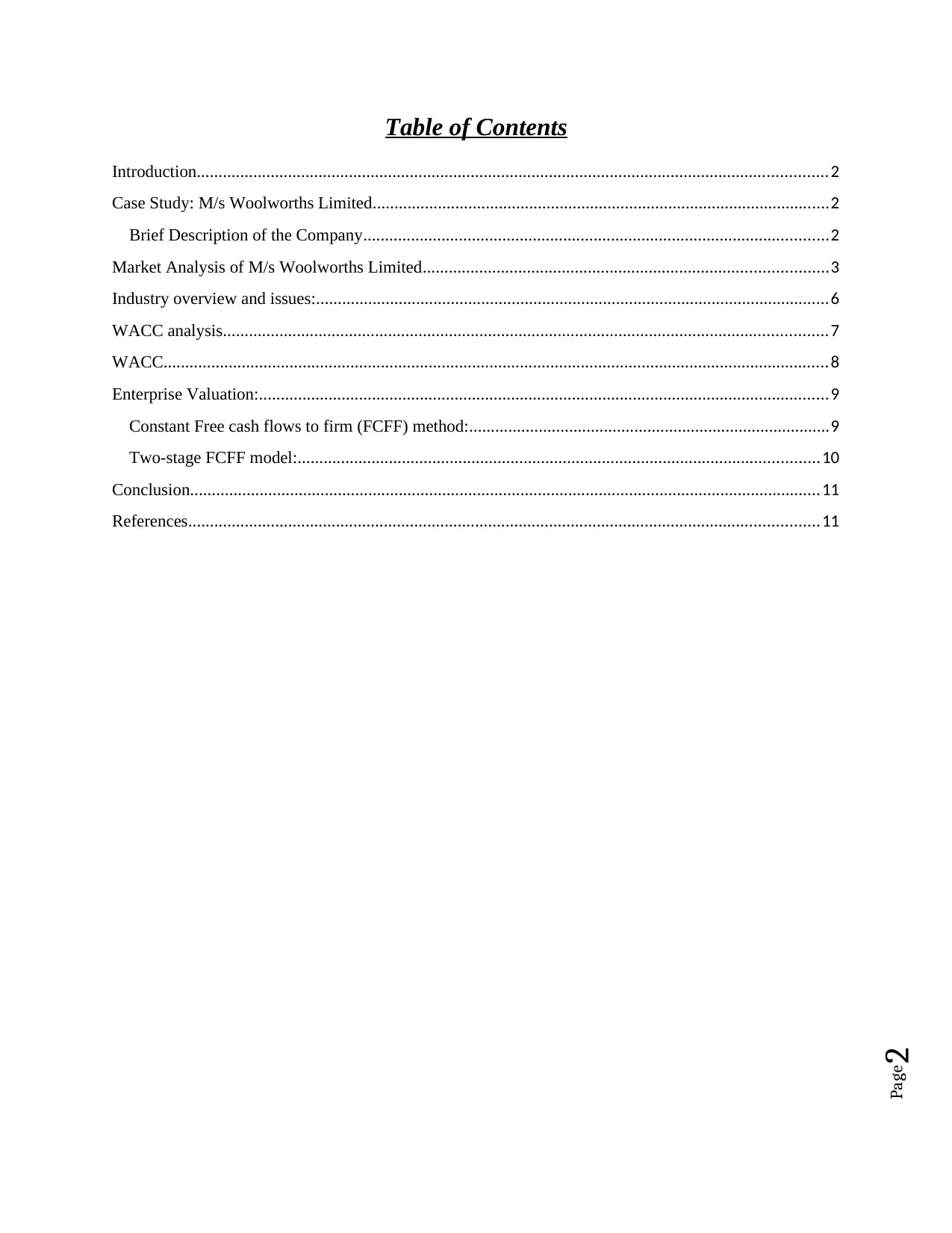
Page2
Table of Contents
Introduction.................................................................................................................................................2
Case Study: M/s Woolworths Limited.........................................................................................................2
Brief Description of the Company...........................................................................................................2
Market Analysis of M/s Woolworths Limited.............................................................................................3
Industry overview and issues:......................................................................................................................6
WACC analysis...........................................................................................................................................7
WACC.........................................................................................................................................................8
Enterprise Valuation:...................................................................................................................................9
Constant Free cash flows to firm (FCFF) method:...................................................................................9
Two-stage FCFF model:........................................................................................................................10
Conclusion.................................................................................................................................................11
References.................................................................................................................................................11
Table of Contents
Introduction.................................................................................................................................................2
Case Study: M/s Woolworths Limited.........................................................................................................2
Brief Description of the Company...........................................................................................................2
Market Analysis of M/s Woolworths Limited.............................................................................................3
Industry overview and issues:......................................................................................................................6
WACC analysis...........................................................................................................................................7
WACC.........................................................................................................................................................8
Enterprise Valuation:...................................................................................................................................9
Constant Free cash flows to firm (FCFF) method:...................................................................................9
Two-stage FCFF model:........................................................................................................................10
Conclusion.................................................................................................................................................11
References.................................................................................................................................................11
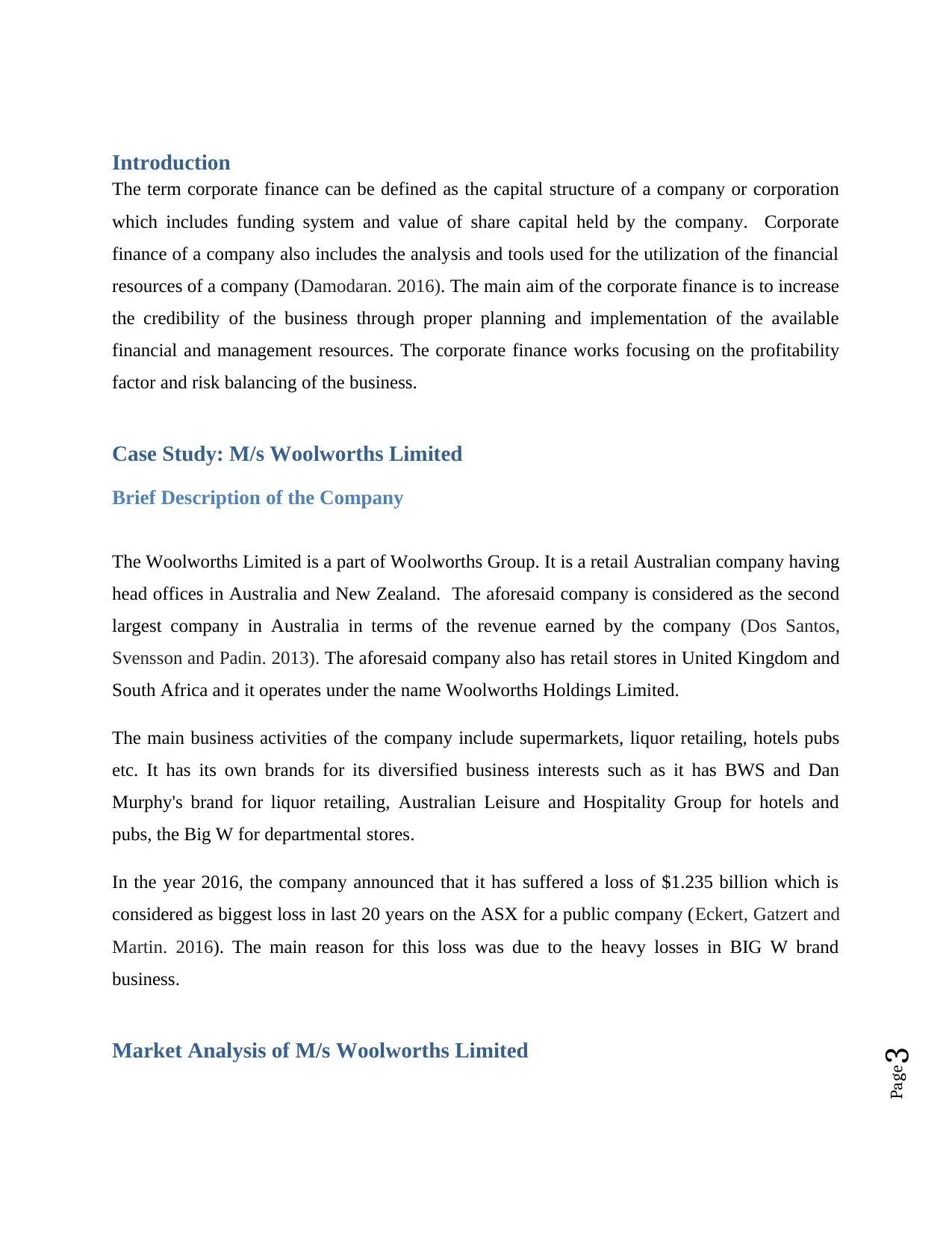
Page3
Introduction
The term corporate finance can be defined as the capital structure of a company or corporation
which includes funding system and value of share capital held by the company. Corporate
finance of a company also includes the analysis and tools used for the utilization of the financial
resources of a company (Damodaran. 2016). The main aim of the corporate finance is to increase
the credibility of the business through proper planning and implementation of the available
financial and management resources. The corporate finance works focusing on the profitability
factor and risk balancing of the business.
Case Study: M/s Woolworths Limited
Brief Description of the Company
The Woolworths Limited is a part of Woolworths Group. It is a retail Australian company having
head offices in Australia and New Zealand. The aforesaid company is considered as the second
largest company in Australia in terms of the revenue earned by the company (Dos Santos,
Svensson and Padin. 2013). The aforesaid company also has retail stores in United Kingdom and
South Africa and it operates under the name Woolworths Holdings Limited.
The main business activities of the company include supermarkets, liquor retailing, hotels pubs
etc. It has its own brands for its diversified business interests such as it has BWS and Dan
Murphy's brand for liquor retailing, Australian Leisure and Hospitality Group for hotels and
pubs, the Big W for departmental stores.
In the year 2016, the company announced that it has suffered a loss of $1.235 billion which is
considered as biggest loss in last 20 years on the ASX for a public company (Eckert, Gatzert and
Martin. 2016). The main reason for this loss was due to the heavy losses in BIG W brand
business.
Market Analysis of M/s Woolworths Limited
Introduction
The term corporate finance can be defined as the capital structure of a company or corporation
which includes funding system and value of share capital held by the company. Corporate
finance of a company also includes the analysis and tools used for the utilization of the financial
resources of a company (Damodaran. 2016). The main aim of the corporate finance is to increase
the credibility of the business through proper planning and implementation of the available
financial and management resources. The corporate finance works focusing on the profitability
factor and risk balancing of the business.
Case Study: M/s Woolworths Limited
Brief Description of the Company
The Woolworths Limited is a part of Woolworths Group. It is a retail Australian company having
head offices in Australia and New Zealand. The aforesaid company is considered as the second
largest company in Australia in terms of the revenue earned by the company (Dos Santos,
Svensson and Padin. 2013). The aforesaid company also has retail stores in United Kingdom and
South Africa and it operates under the name Woolworths Holdings Limited.
The main business activities of the company include supermarkets, liquor retailing, hotels pubs
etc. It has its own brands for its diversified business interests such as it has BWS and Dan
Murphy's brand for liquor retailing, Australian Leisure and Hospitality Group for hotels and
pubs, the Big W for departmental stores.
In the year 2016, the company announced that it has suffered a loss of $1.235 billion which is
considered as biggest loss in last 20 years on the ASX for a public company (Eckert, Gatzert and
Martin. 2016). The main reason for this loss was due to the heavy losses in BIG W brand
business.
Market Analysis of M/s Woolworths Limited
⊘ This is a preview!⊘
Do you want full access?
Subscribe today to unlock all pages.

Trusted by 1+ million students worldwide
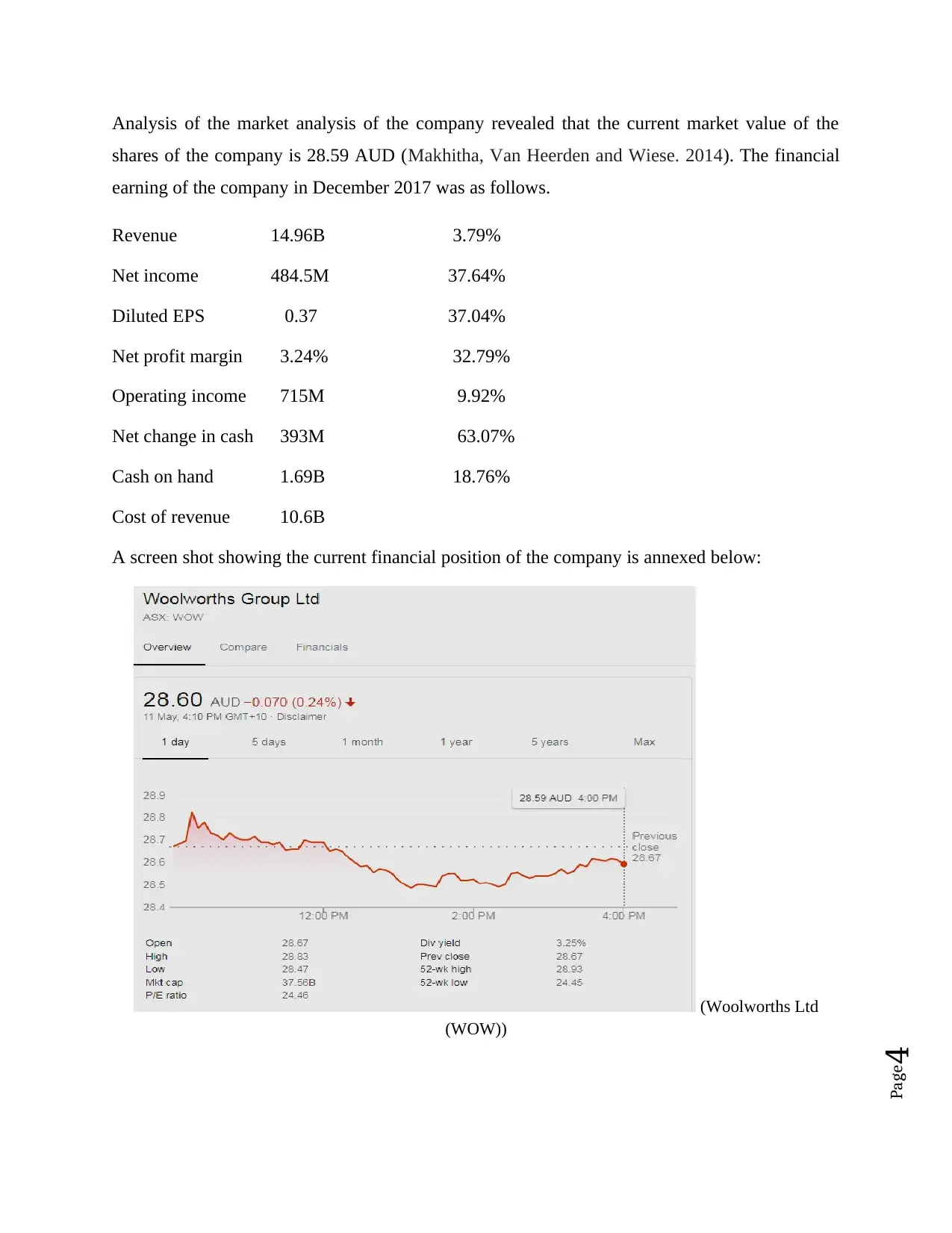
Page4
Analysis of the market analysis of the company revealed that the current market value of the
shares of the company is 28.59 AUD (Makhitha, Van Heerden and Wiese. 2014). The financial
earning of the company in December 2017 was as follows.
Revenue 14.96B 3.79%
Net income 484.5M 37.64%
Diluted EPS 0.37 37.04%
Net profit margin 3.24% 32.79%
Operating income 715M 9.92%
Net change in cash 393M 63.07%
Cash on hand 1.69B 18.76%
Cost of revenue 10.6B
A screen shot showing the current financial position of the company is annexed below:
(Woolworths Ltd
(WOW))
Analysis of the market analysis of the company revealed that the current market value of the
shares of the company is 28.59 AUD (Makhitha, Van Heerden and Wiese. 2014). The financial
earning of the company in December 2017 was as follows.
Revenue 14.96B 3.79%
Net income 484.5M 37.64%
Diluted EPS 0.37 37.04%
Net profit margin 3.24% 32.79%
Operating income 715M 9.92%
Net change in cash 393M 63.07%
Cash on hand 1.69B 18.76%
Cost of revenue 10.6B
A screen shot showing the current financial position of the company is annexed below:
(Woolworths Ltd
(WOW))
Paraphrase This Document
Need a fresh take? Get an instant paraphrase of this document with our AI Paraphraser
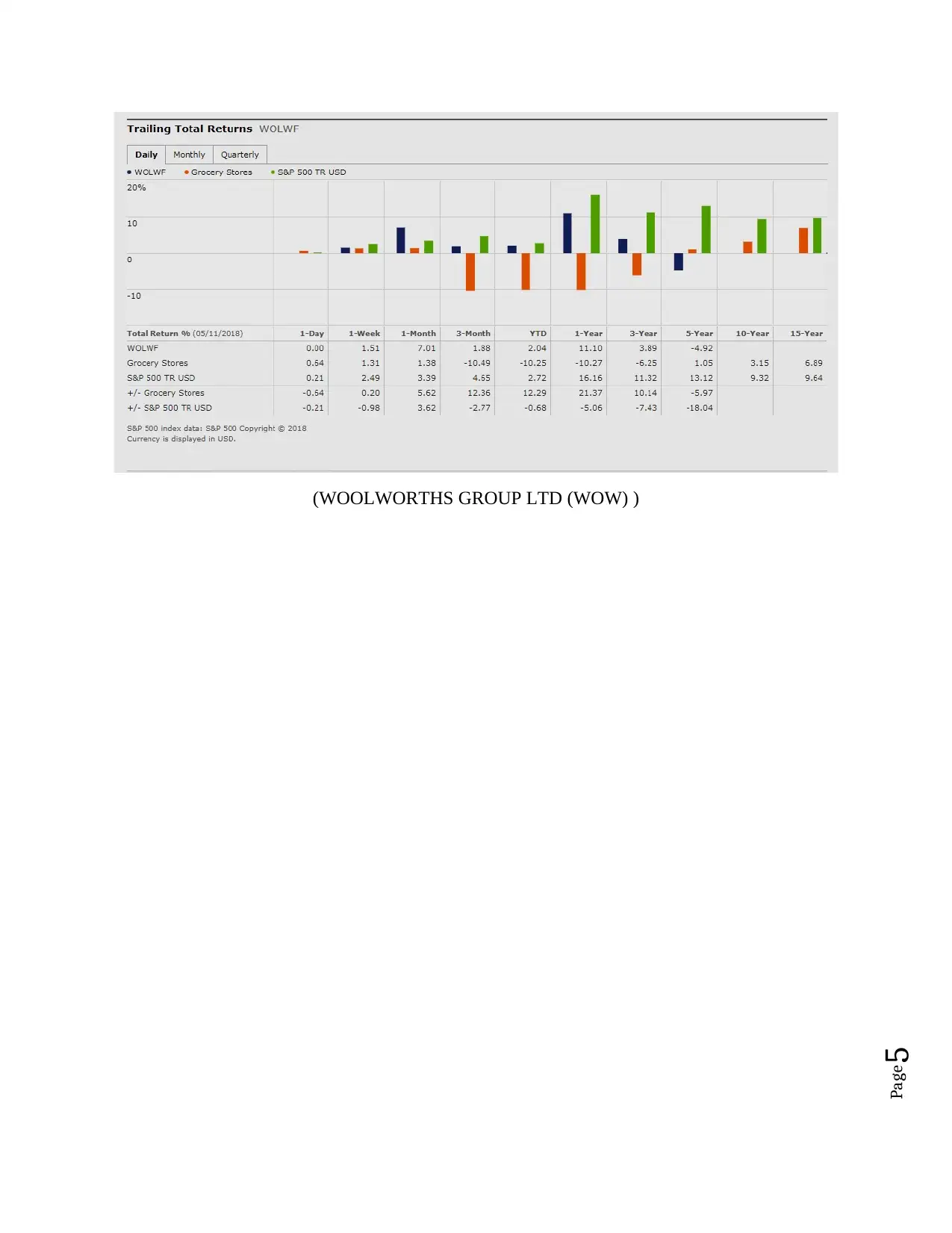
Page5
(WOOLWORTHS GROUP LTD (WOW) )
(WOOLWORTHS GROUP LTD (WOW) )
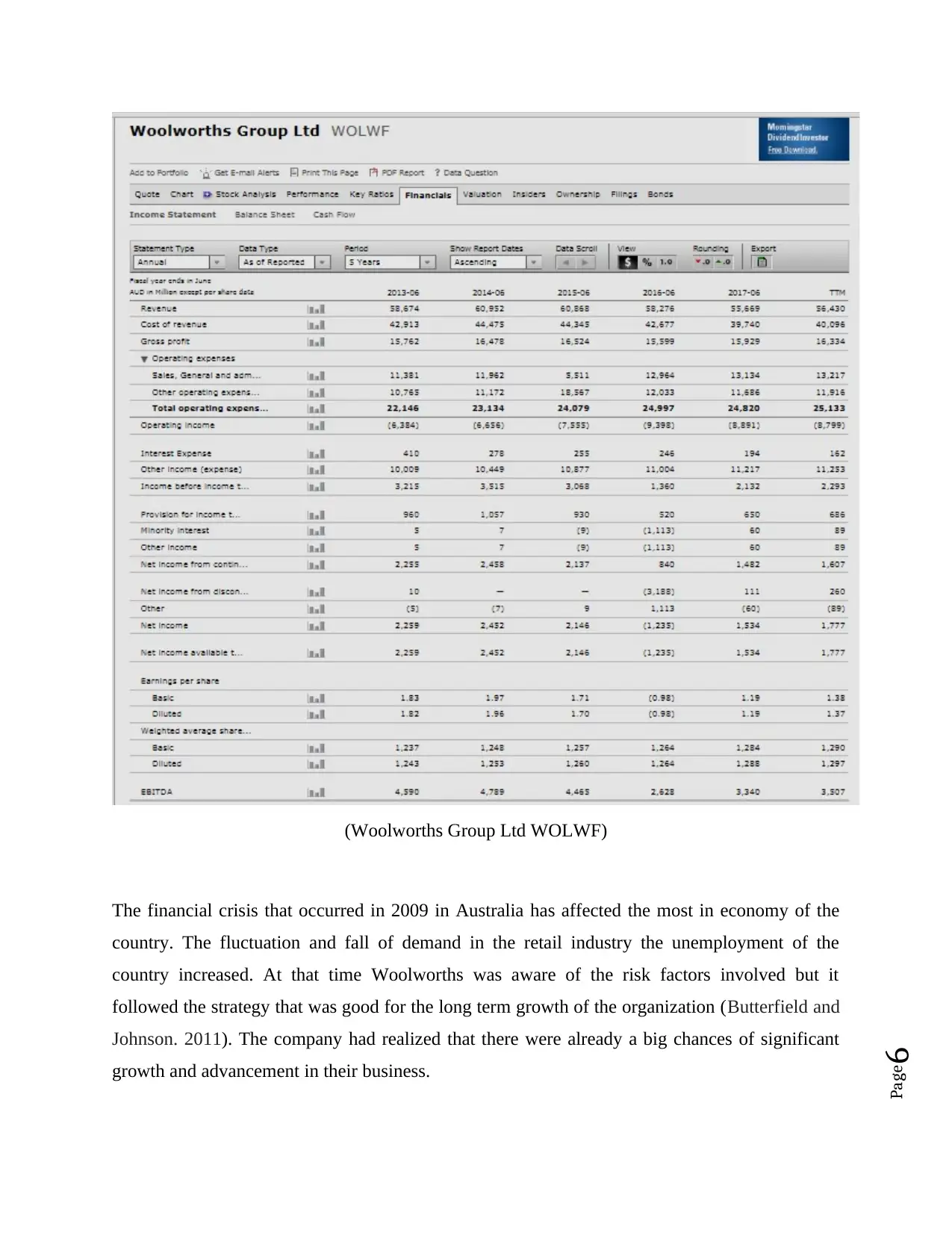
Page6
(Woolworths Group Ltd WOLWF)
The financial crisis that occurred in 2009 in Australia has affected the most in economy of the
country. The fluctuation and fall of demand in the retail industry the unemployment of the
country increased. At that time Woolworths was aware of the risk factors involved but it
followed the strategy that was good for the long term growth of the organization (Butterfield and
Johnson. 2011). The company had realized that there were already a big chances of significant
growth and advancement in their business.
(Woolworths Group Ltd WOLWF)
The financial crisis that occurred in 2009 in Australia has affected the most in economy of the
country. The fluctuation and fall of demand in the retail industry the unemployment of the
country increased. At that time Woolworths was aware of the risk factors involved but it
followed the strategy that was good for the long term growth of the organization (Butterfield and
Johnson. 2011). The company had realized that there were already a big chances of significant
growth and advancement in their business.
⊘ This is a preview!⊘
Do you want full access?
Subscribe today to unlock all pages.

Trusted by 1+ million students worldwide
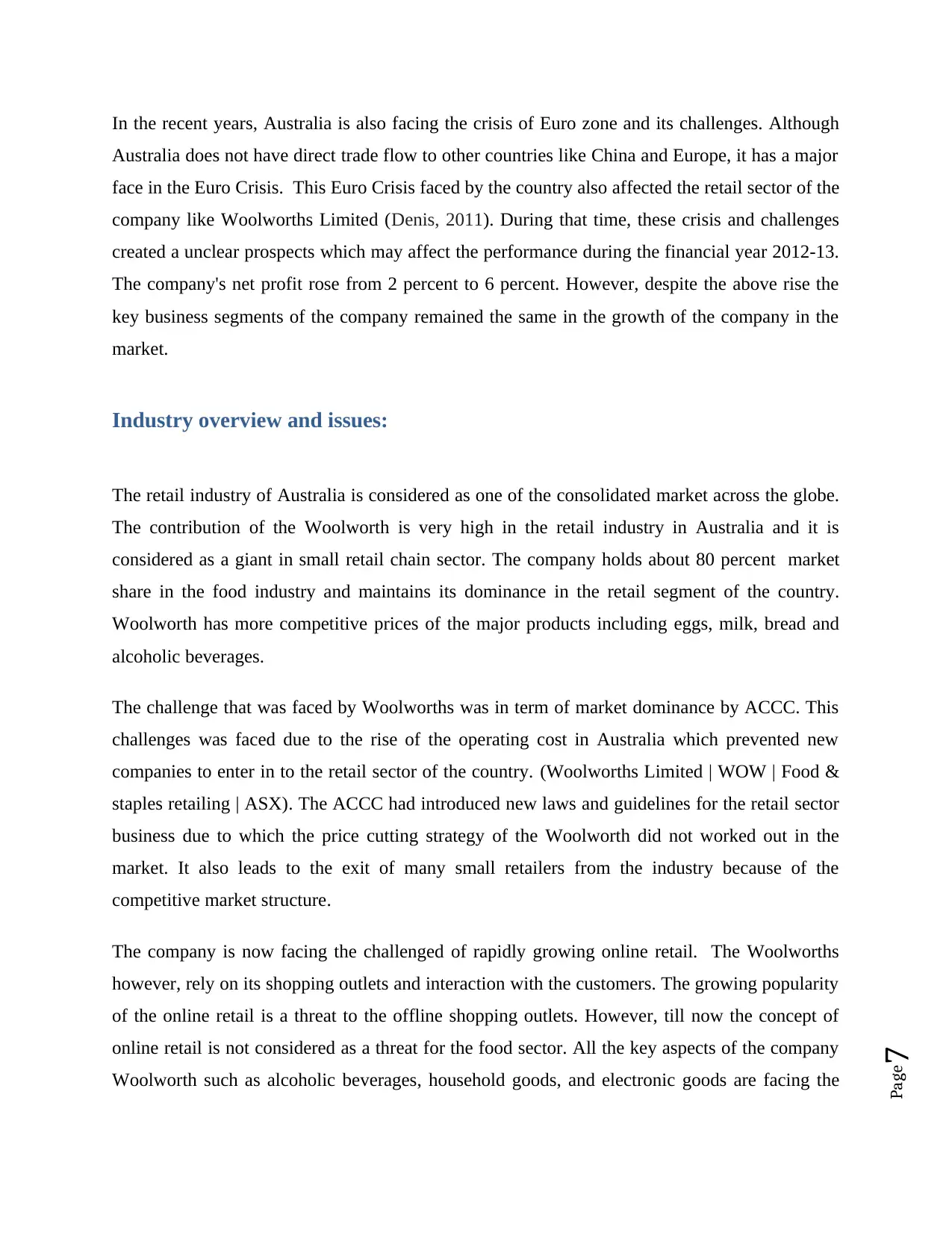
Page7
In the recent years, Australia is also facing the crisis of Euro zone and its challenges. Although
Australia does not have direct trade flow to other countries like China and Europe, it has a major
face in the Euro Crisis. This Euro Crisis faced by the country also affected the retail sector of the
company like Woolworths Limited (Denis, 2011). During that time, these crisis and challenges
created a unclear prospects which may affect the performance during the financial year 2012-13.
The company's net profit rose from 2 percent to 6 percent. However, despite the above rise the
key business segments of the company remained the same in the growth of the company in the
market.
Industry overview and issues:
The retail industry of Australia is considered as one of the consolidated market across the globe.
The contribution of the Woolworth is very high in the retail industry in Australia and it is
considered as a giant in small retail chain sector. The company holds about 80 percent market
share in the food industry and maintains its dominance in the retail segment of the country.
Woolworth has more competitive prices of the major products including eggs, milk, bread and
alcoholic beverages.
The challenge that was faced by Woolworths was in term of market dominance by ACCC. This
challenges was faced due to the rise of the operating cost in Australia which prevented new
companies to enter in to the retail sector of the country. (Woolworths Limited | WOW | Food &
staples retailing | ASX). The ACCC had introduced new laws and guidelines for the retail sector
business due to which the price cutting strategy of the Woolworth did not worked out in the
market. It also leads to the exit of many small retailers from the industry because of the
competitive market structure.
The company is now facing the challenged of rapidly growing online retail. The Woolworths
however, rely on its shopping outlets and interaction with the customers. The growing popularity
of the online retail is a threat to the offline shopping outlets. However, till now the concept of
online retail is not considered as a threat for the food sector. All the key aspects of the company
Woolworth such as alcoholic beverages, household goods, and electronic goods are facing the
In the recent years, Australia is also facing the crisis of Euro zone and its challenges. Although
Australia does not have direct trade flow to other countries like China and Europe, it has a major
face in the Euro Crisis. This Euro Crisis faced by the country also affected the retail sector of the
company like Woolworths Limited (Denis, 2011). During that time, these crisis and challenges
created a unclear prospects which may affect the performance during the financial year 2012-13.
The company's net profit rose from 2 percent to 6 percent. However, despite the above rise the
key business segments of the company remained the same in the growth of the company in the
market.
Industry overview and issues:
The retail industry of Australia is considered as one of the consolidated market across the globe.
The contribution of the Woolworth is very high in the retail industry in Australia and it is
considered as a giant in small retail chain sector. The company holds about 80 percent market
share in the food industry and maintains its dominance in the retail segment of the country.
Woolworth has more competitive prices of the major products including eggs, milk, bread and
alcoholic beverages.
The challenge that was faced by Woolworths was in term of market dominance by ACCC. This
challenges was faced due to the rise of the operating cost in Australia which prevented new
companies to enter in to the retail sector of the country. (Woolworths Limited | WOW | Food &
staples retailing | ASX). The ACCC had introduced new laws and guidelines for the retail sector
business due to which the price cutting strategy of the Woolworth did not worked out in the
market. It also leads to the exit of many small retailers from the industry because of the
competitive market structure.
The company is now facing the challenged of rapidly growing online retail. The Woolworths
however, rely on its shopping outlets and interaction with the customers. The growing popularity
of the online retail is a threat to the offline shopping outlets. However, till now the concept of
online retail is not considered as a threat for the food sector. All the key aspects of the company
Woolworth such as alcoholic beverages, household goods, and electronic goods are facing the
Paraphrase This Document
Need a fresh take? Get an instant paraphrase of this document with our AI Paraphraser
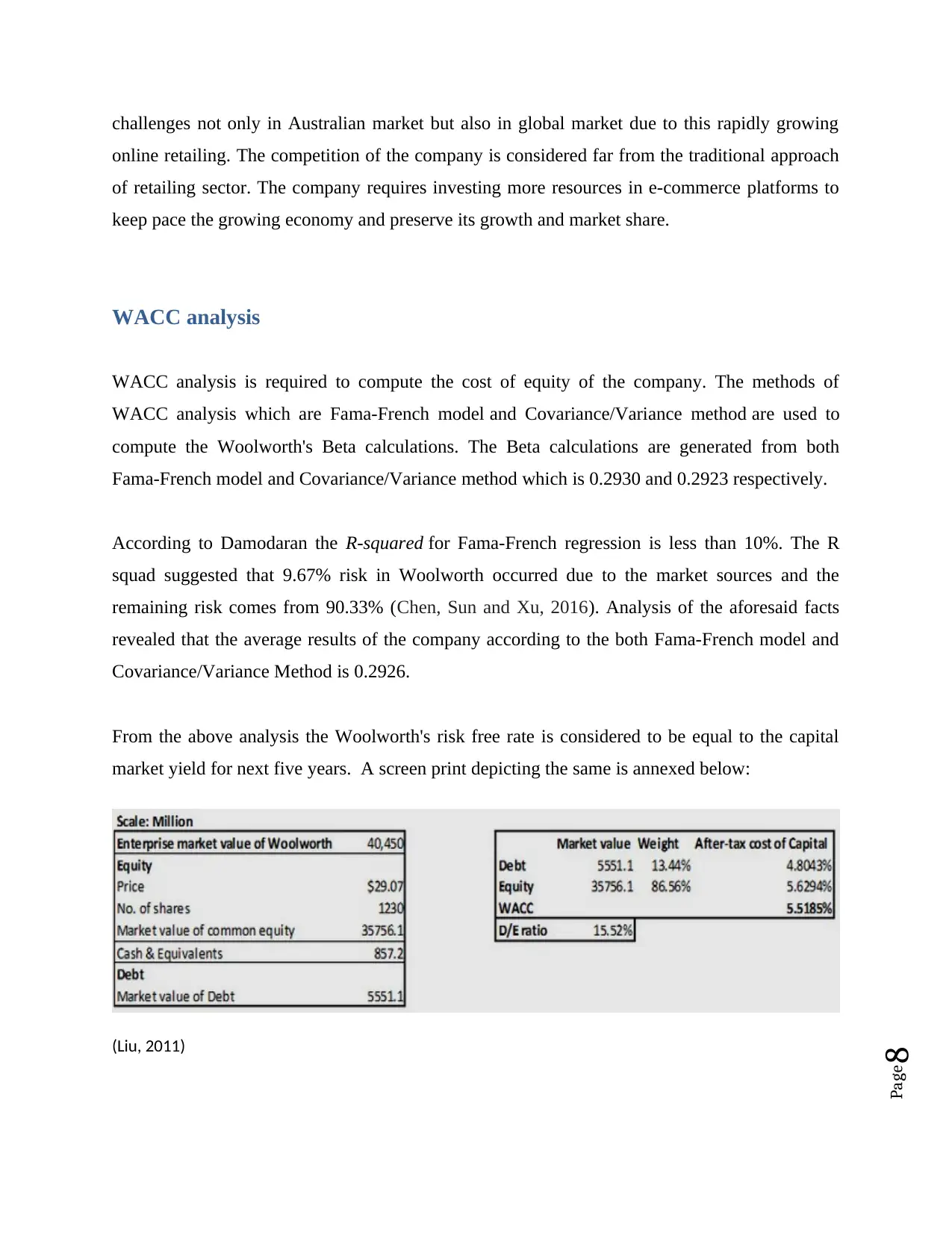
Page8
challenges not only in Australian market but also in global market due to this rapidly growing
online retailing. The competition of the company is considered far from the traditional approach
of retailing sector. The company requires investing more resources in e-commerce platforms to
keep pace the growing economy and preserve its growth and market share.
WACC analysis
WACC analysis is required to compute the cost of equity of the company. The methods of
WACC analysis which are Fama-French model and Covariance/Variance method are used to
compute the Woolworth's Beta calculations. The Beta calculations are generated from both
Fama-French model and Covariance/Variance method which is 0.2930 and 0.2923 respectively.
According to Damodaran the R-squared for Fama-French regression is less than 10%. The R
squad suggested that 9.67% risk in Woolworth occurred due to the market sources and the
remaining risk comes from 90.33% (Chen, Sun and Xu, 2016). Analysis of the aforesaid facts
revealed that the average results of the company according to the both Fama-French model and
Covariance/Variance Method is 0.2926.
From the above analysis the Woolworth's risk free rate is considered to be equal to the capital
market yield for next five years. A screen print depicting the same is annexed below:
(Liu, 2011)
challenges not only in Australian market but also in global market due to this rapidly growing
online retailing. The competition of the company is considered far from the traditional approach
of retailing sector. The company requires investing more resources in e-commerce platforms to
keep pace the growing economy and preserve its growth and market share.
WACC analysis
WACC analysis is required to compute the cost of equity of the company. The methods of
WACC analysis which are Fama-French model and Covariance/Variance method are used to
compute the Woolworth's Beta calculations. The Beta calculations are generated from both
Fama-French model and Covariance/Variance method which is 0.2930 and 0.2923 respectively.
According to Damodaran the R-squared for Fama-French regression is less than 10%. The R
squad suggested that 9.67% risk in Woolworth occurred due to the market sources and the
remaining risk comes from 90.33% (Chen, Sun and Xu, 2016). Analysis of the aforesaid facts
revealed that the average results of the company according to the both Fama-French model and
Covariance/Variance Method is 0.2926.
From the above analysis the Woolworth's risk free rate is considered to be equal to the capital
market yield for next five years. A screen print depicting the same is annexed below:
(Liu, 2011)
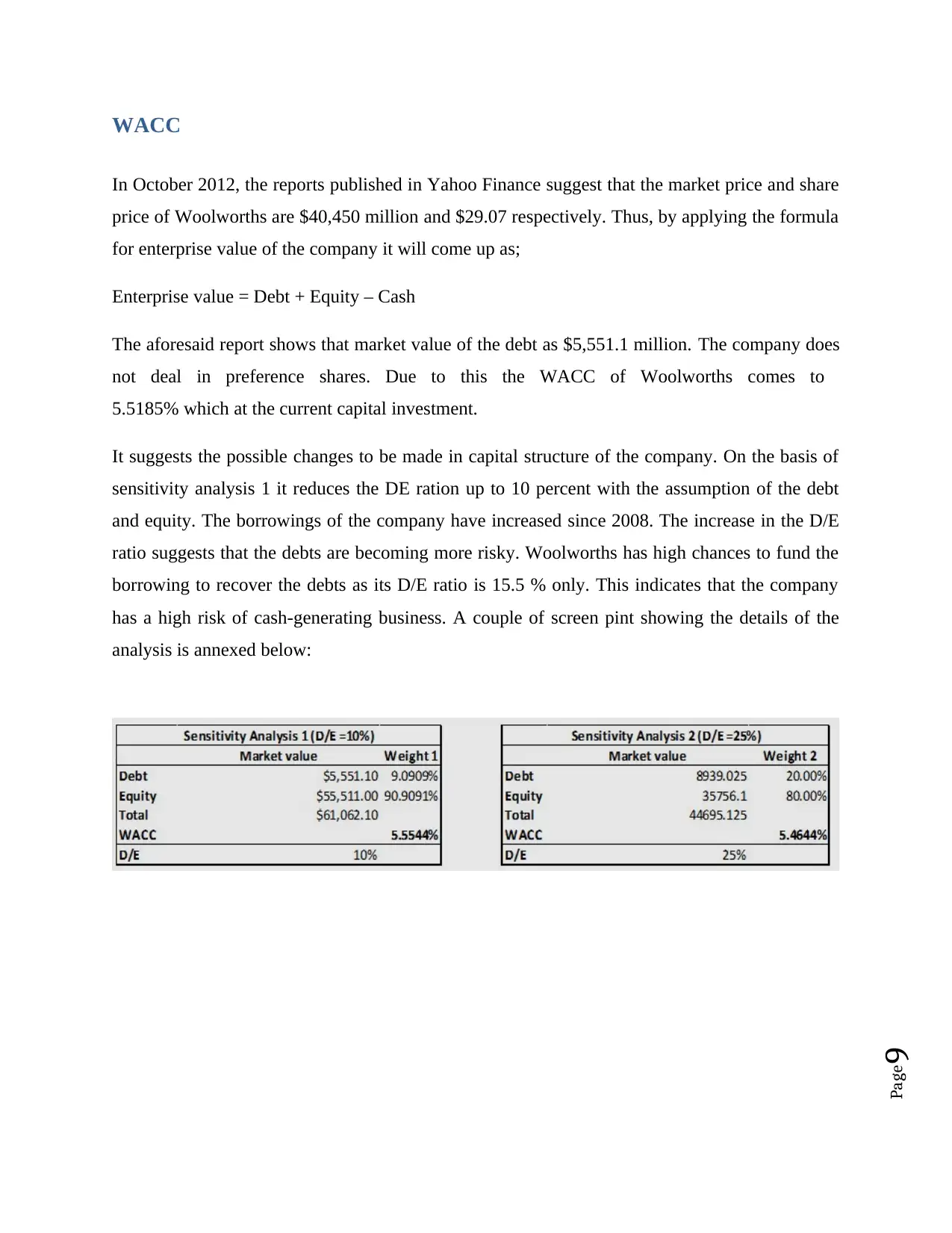
Page9
WACC
In October 2012, the reports published in Yahoo Finance suggest that the market price and share
price of Woolworths are $40,450 million and $29.07 respectively. Thus, by applying the formula
for enterprise value of the company it will come up as;
Enterprise value = Debt + Equity – Cash
The aforesaid report shows that market value of the debt as $5,551.1 million. The company does
not deal in preference shares. Due to this the WACC of Woolworths comes to
5.5185% which at the current capital investment.
It suggests the possible changes to be made in capital structure of the company. On the basis of
sensitivity analysis 1 it reduces the DE ration up to 10 percent with the assumption of the debt
and equity. The borrowings of the company have increased since 2008. The increase in the D/E
ratio suggests that the debts are becoming more risky. Woolworths has high chances to fund the
borrowing to recover the debts as its D/E ratio is 15.5 % only. This indicates that the company
has a high risk of cash-generating business. A couple of screen pint showing the details of the
analysis is annexed below:
WACC
In October 2012, the reports published in Yahoo Finance suggest that the market price and share
price of Woolworths are $40,450 million and $29.07 respectively. Thus, by applying the formula
for enterprise value of the company it will come up as;
Enterprise value = Debt + Equity – Cash
The aforesaid report shows that market value of the debt as $5,551.1 million. The company does
not deal in preference shares. Due to this the WACC of Woolworths comes to
5.5185% which at the current capital investment.
It suggests the possible changes to be made in capital structure of the company. On the basis of
sensitivity analysis 1 it reduces the DE ration up to 10 percent with the assumption of the debt
and equity. The borrowings of the company have increased since 2008. The increase in the D/E
ratio suggests that the debts are becoming more risky. Woolworths has high chances to fund the
borrowing to recover the debts as its D/E ratio is 15.5 % only. This indicates that the company
has a high risk of cash-generating business. A couple of screen pint showing the details of the
analysis is annexed below:
⊘ This is a preview!⊘
Do you want full access?
Subscribe today to unlock all pages.

Trusted by 1+ million students worldwide
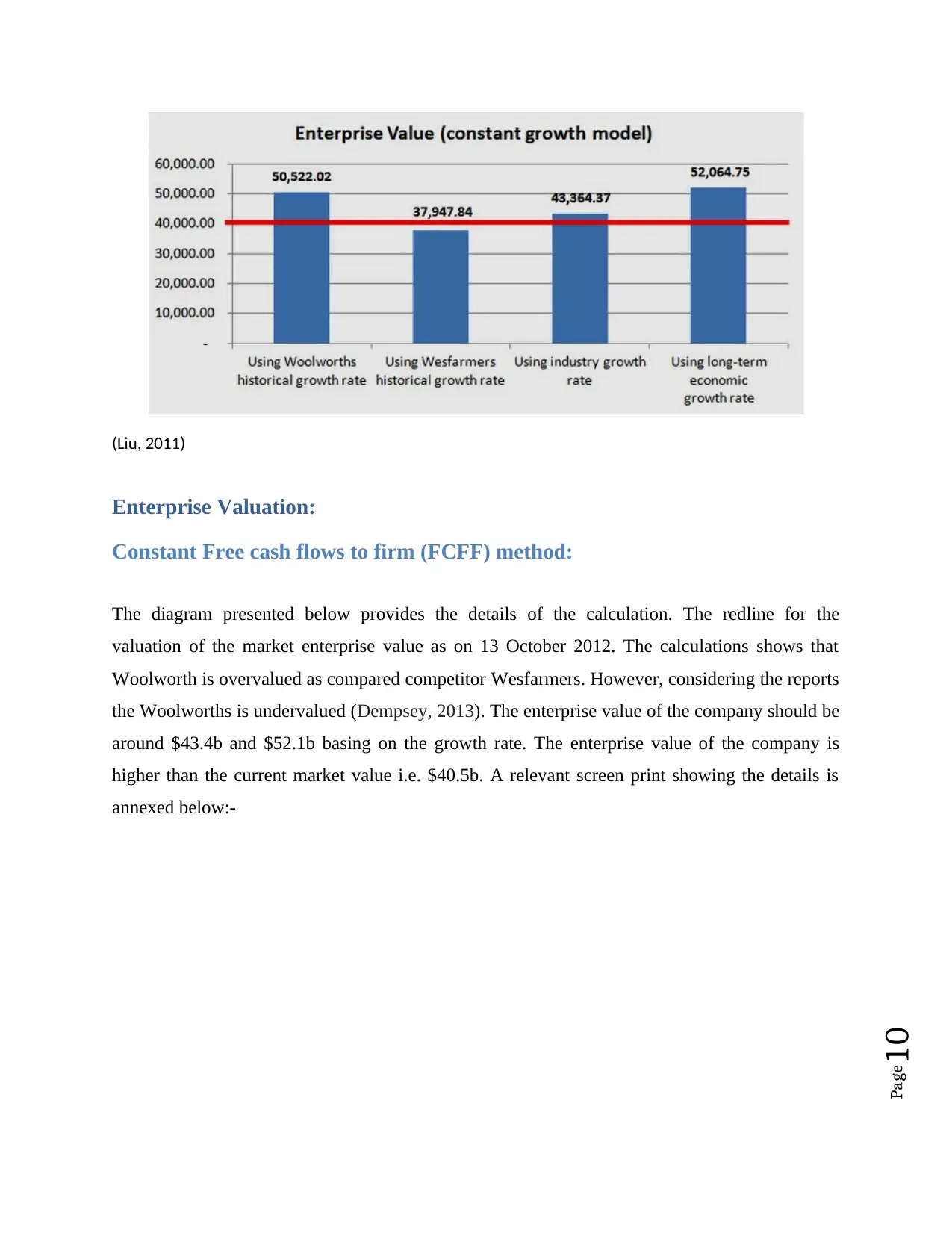
Page10
(Liu, 2011)
Enterprise Valuation:
Constant Free cash flows to firm (FCFF) method:
The diagram presented below provides the details of the calculation. The redline for the
valuation of the market enterprise value as on 13 October 2012. The calculations shows that
Woolworth is overvalued as compared competitor Wesfarmers. However, considering the reports
the Woolworths is undervalued (Dempsey, 2013). The enterprise value of the company should be
around $43.4b and $52.1b basing on the growth rate. The enterprise value of the company is
higher than the current market value i.e. $40.5b. A relevant screen print showing the details is
annexed below:-
(Liu, 2011)
Enterprise Valuation:
Constant Free cash flows to firm (FCFF) method:
The diagram presented below provides the details of the calculation. The redline for the
valuation of the market enterprise value as on 13 October 2012. The calculations shows that
Woolworth is overvalued as compared competitor Wesfarmers. However, considering the reports
the Woolworths is undervalued (Dempsey, 2013). The enterprise value of the company should be
around $43.4b and $52.1b basing on the growth rate. The enterprise value of the company is
higher than the current market value i.e. $40.5b. A relevant screen print showing the details is
annexed below:-
Paraphrase This Document
Need a fresh take? Get an instant paraphrase of this document with our AI Paraphraser
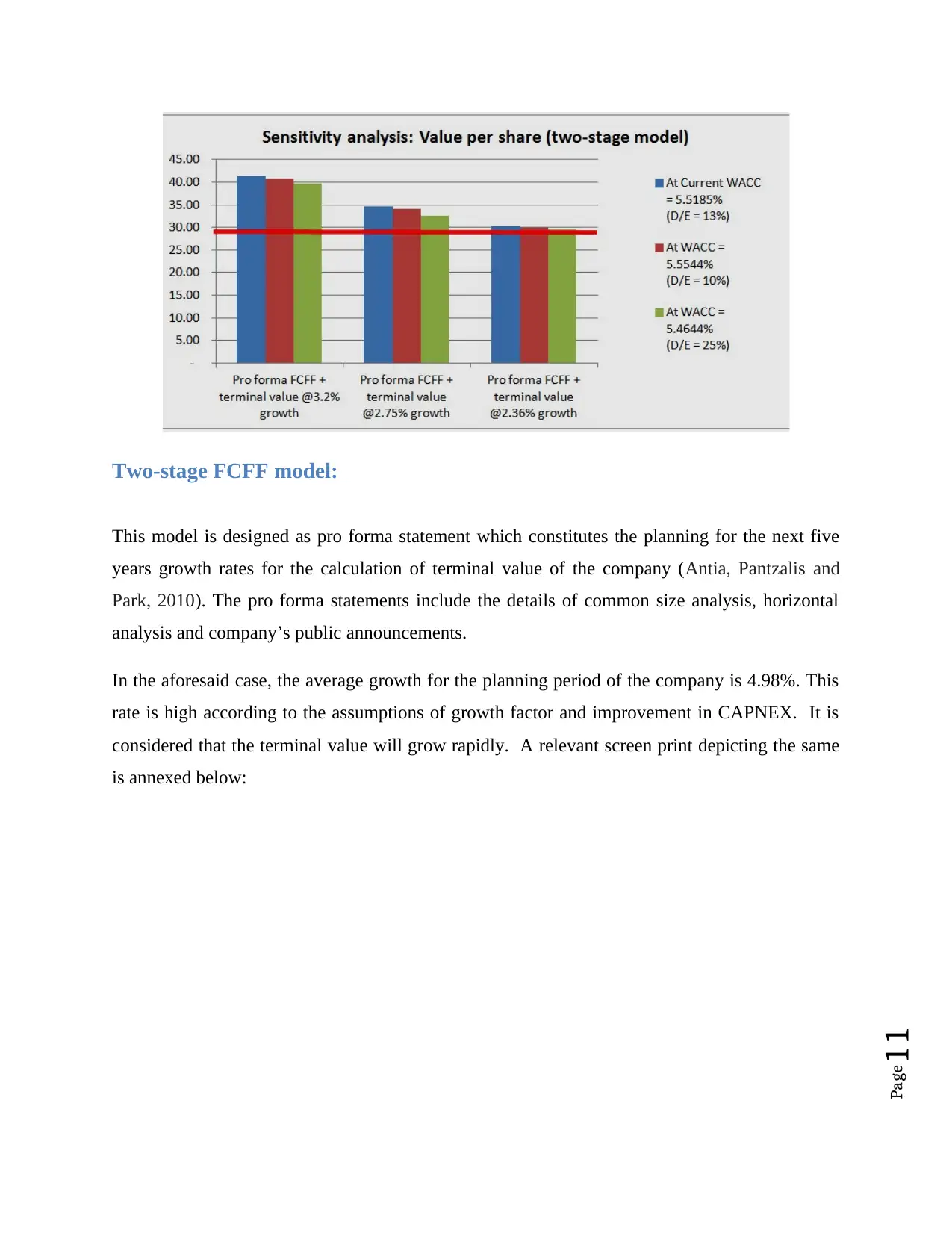
Page11
Two-stage FCFF model:
This model is designed as pro forma statement which constitutes the planning for the next five
years growth rates for the calculation of terminal value of the company (Antia, Pantzalis and
Park, 2010). The pro forma statements include the details of common size analysis, horizontal
analysis and company’s public announcements.
In the aforesaid case, the average growth for the planning period of the company is 4.98%. This
rate is high according to the assumptions of growth factor and improvement in CAPNEX. It is
considered that the terminal value will grow rapidly. A relevant screen print depicting the same
is annexed below:
Two-stage FCFF model:
This model is designed as pro forma statement which constitutes the planning for the next five
years growth rates for the calculation of terminal value of the company (Antia, Pantzalis and
Park, 2010). The pro forma statements include the details of common size analysis, horizontal
analysis and company’s public announcements.
In the aforesaid case, the average growth for the planning period of the company is 4.98%. This
rate is high according to the assumptions of growth factor and improvement in CAPNEX. It is
considered that the terminal value will grow rapidly. A relevant screen print depicting the same
is annexed below:
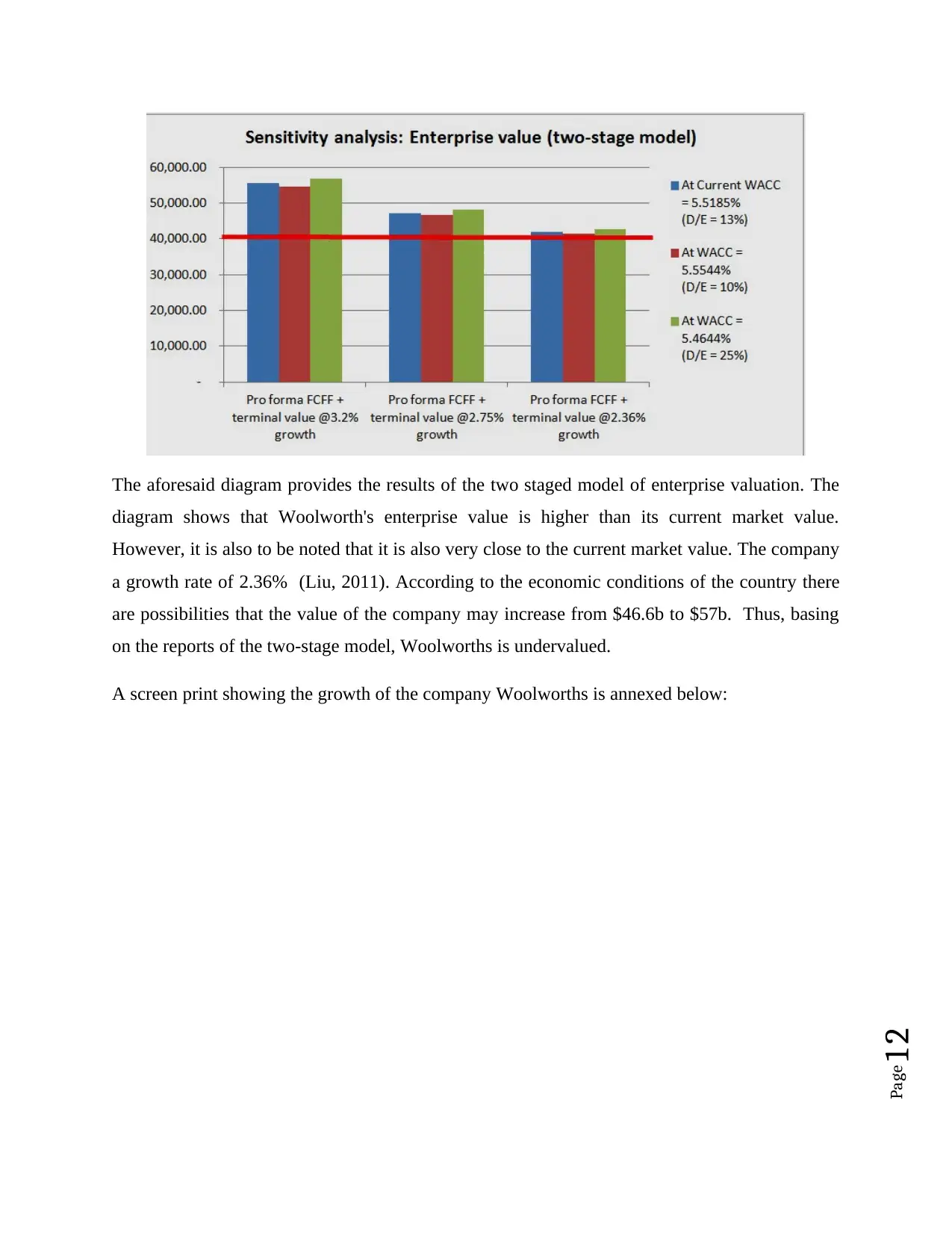
Page12
The aforesaid diagram provides the results of the two staged model of enterprise valuation. The
diagram shows that Woolworth's enterprise value is higher than its current market value.
However, it is also to be noted that it is also very close to the current market value. The company
a growth rate of 2.36% (Liu, 2011). According to the economic conditions of the country there
are possibilities that the value of the company may increase from $46.6b to $57b. Thus, basing
on the reports of the two-stage model, Woolworths is undervalued.
A screen print showing the growth of the company Woolworths is annexed below:
The aforesaid diagram provides the results of the two staged model of enterprise valuation. The
diagram shows that Woolworth's enterprise value is higher than its current market value.
However, it is also to be noted that it is also very close to the current market value. The company
a growth rate of 2.36% (Liu, 2011). According to the economic conditions of the country there
are possibilities that the value of the company may increase from $46.6b to $57b. Thus, basing
on the reports of the two-stage model, Woolworths is undervalued.
A screen print showing the growth of the company Woolworths is annexed below:
⊘ This is a preview!⊘
Do you want full access?
Subscribe today to unlock all pages.

Trusted by 1+ million students worldwide
1 out of 15
Related Documents
Your All-in-One AI-Powered Toolkit for Academic Success.
+13062052269
info@desklib.com
Available 24*7 on WhatsApp / Email
![[object Object]](/_next/static/media/star-bottom.7253800d.svg)
Unlock your academic potential
Copyright © 2020–2025 A2Z Services. All Rights Reserved. Developed and managed by ZUCOL.





